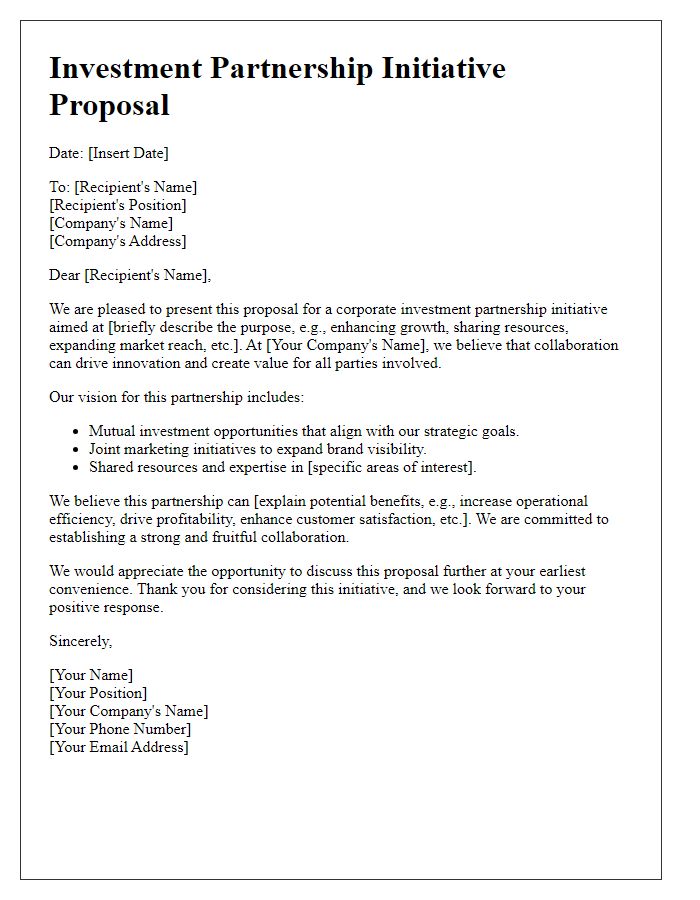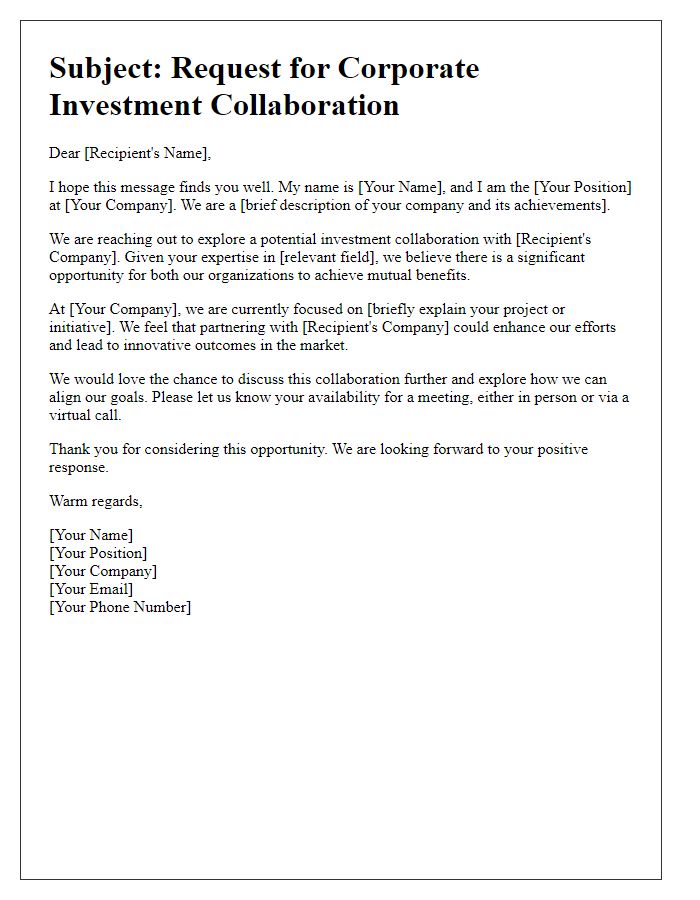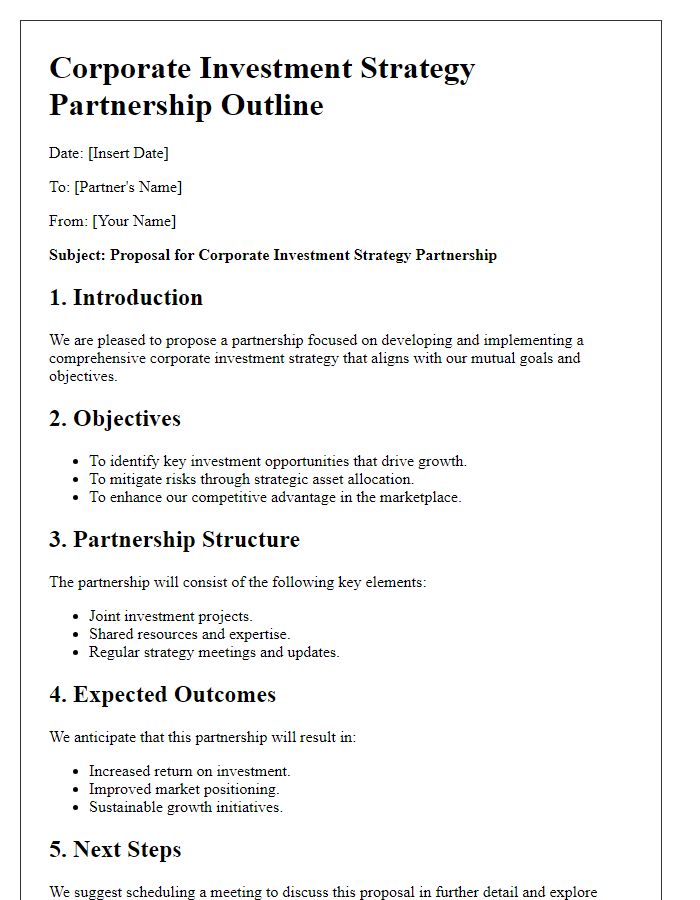Are you looking to elevate your company's growth potential through strategic partnerships? Crafting a compelling corporate investment partnership proposal can be the key to unlocking new opportunities and fostering meaningful collaborations. In this article, we'll guide you through essential elements to include in your proposal, ensuring that it resonates with potential investors and aligns with their goals. So, let's dive in and explore the best practices for creating an impactful letter that attracts investment interest!

Clear Objectives and Goals
A corporate investment partnership proposal requires clear objectives and goals to ensure alignment between the organizations involved. Establishing measurable key performance indicators (KPIs) related to financial returns, market expansion, and innovation targets is essential. For instance, aiming for a 20% increase in revenue within the first year and expanding into three new geographical markets can be defined as concrete goals. Additionally, fostering collaboration on sustainability initiatives, such as reducing carbon emissions by 30% over five years, can enhance corporate social responsibility (CSR) efforts. Building a shared vision of success, valuation metrics, and exit strategies will strengthen the partnership and create a framework for accountability and ongoing evaluation.
Detailed Investment Proposal
A detailed investment proposal outlines strategic opportunities for corporate partnership, addressing potential benefits for stakeholders involved. This document typically includes sections on market analysis, evaluating industry trends such as consumer behavior changes post-COVID-19, financial projections with estimated return on investment (ROI) percentages, and risk assessment encompassing geopolitical factors affecting global markets. The proposal may highlight the corporate entity's past successful partnerships with notable companies, such as joint ventures or collaborations, emphasizing synergies and shared values in corporate social responsibility (CSR). Further, it outlines specific investment needs, project timelines, and key performance indicators (KPIs) to gauge success. The proposal often emphasizes the value of leveraging combined resources, expertise, and networks to drive innovation and competitiveness in targeted sectors like technology, renewable energy, or healthcare.
Strong Value Proposition
Crafting a successful corporate investment partnership proposal requires a compelling value proposition that clearly outlines the mutual benefits and synergies between the organizations involved. The proposal must detail specific financial returns, such as projected ROI percentages or revenue increases based on historical data. Highlight successful case studies or partnerships from relevant industries, such as technology or healthcare, showcasing how collaboration led to innovation and market expansion. The proposal should also include a thorough market analysis, referencing rising trends or consumer demands supported by statistical evidence. Additionally, addressing the partnership's social responsibility initiatives can enhance appeal, aligning with corporate sustainability goals and leading to a more positive public perception. Key performance indicators (KPIs) can be included to measure success, focusing on metrics like market share growth and profitability enhancements. Overall, the proposal should present a strong, data-driven narrative that illustrates a win-win situation for both parties, fostering an environment of trust and shared vision for the future.
Partnership Benefits and Synergies
Strategic partnerships can unlock numerous benefits and synergies for corporate entities, enhancing growth potential and operational efficiency. Financial backing from investment partners can provide access to additional capital, allowing for expansion initiatives in rapidly growing markets like Southeast Asia. Resource sharing, such as technology and expertise, can create operational efficiencies and drive innovation, particularly in sectors like renewable energy and artificial intelligence. Furthermore, co-marketing strategies can amplify brand visibility and reach, leveraging the combined customer bases of each partner. Collaboration on projects can foster knowledge sharing and best practices, ultimately leading to enhanced product offerings and customer satisfaction.
Projected Financial Outcomes
Projected financial outcomes in corporate investment partnerships can vary significantly based on several factors, including market conditions, industry trends, and strategic alignment. For instance, a technology startup focused on artificial intelligence may anticipate a growth rate of 25% annually, driven by increasing demand for automation solutions across various sectors such as healthcare, finance, and logistics. In comparison, an environmentally-focused venture capital fund may project returns in the range of 15-20% over a five-year horizon, capitalizing on the growing importance of sustainability initiatives and regulatory support in regions like Europe and North America. Detailed analysis of financial metrics such as EBITDA (earnings before interest, taxes, depreciation, and amortization) and ROI (return on investment) should be included in calculations, along with sensitivity analyses that assess potential impacts of market fluctuations and operational efficiencies. Robust forecasts can also consider diverse exit strategies, including strategic acquisitions or IPOs (initial public offerings), which may enhance liquidity and long-term value creation for all stakeholders involved.
Letter Template For Corporate Investment Partnership Proposal Samples
Letter template of corporate investment partnership opportunity overview

Letter template of corporate investment partnership benefits articulation












Comments